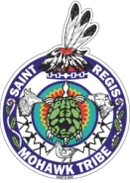-
Community & Family Services
- Care Management Program
- Child Support Enforcement Unit
- Family Support
- HCBS Waiver
- Home Improvement Supplement Program (HIP)
- Homeowner's Assistance Fund
- Individual Residential Alternatives (IRA)
- Individual Supports and Services (ISS) - Housing Subsidy Program
- Office of the Family Advocate
- Three Sisters Program
- Tribal Vocational Rehabilitation (TVR)
- Community Partnership Fund
- Economic Development
- Education
- Environment
- Executive Director's Office
- Finance
- Generations Park
- Grants & Contracts
-
Health Services
- A/CDP Outpatient
- A/CDP Prevention
- Partridge House (Inpatient)
- Ronthahiiohsthá:ke Clubhouse
- Business Office
- Centering Pregnancy
- Dental Clinic
- Health Promotion and Planning
- Laboratory
- Let's Get Healthy - Diabetes Center for Excellence
- Medical Clinic
- Mental Health - Kanikonri:ihne (Good Mind Counseling)
- Outreach Chronic Care Nursing
- Pharmacy
- School-Based Health Center
- Home Improvement Supplement Program (HIP)
- Human Resources
- Office for the Aging
- Office of Emergency Management and Safety
- Planning and Infrastructure
- Social Services Division
- Tribal Historic Preservation Office
- Tribal Police
Tribal Invasive Plant Management Initiative: Phragmites
The Tribal Invasive Plant Management Initiative is a multi-year restoration project coordinated by the Saint Regis Mohawk Tribe (SRMT) Environment Division in conjunction with the U.S. Environmental Protection Agency (USEPA), and funded by the Great Lakes Restoration Initiative (GLRI).
The targeted species for this project is invasive phragmites (Phragmites australis), which has become increasingly problematic since this aggressive plant’s rapid growth and spread has led to a number of adverse ecological impacts. The establishment of this plant species is harmful since it is capable of outcompeting native species for nutrients and water, altering wetland hydrology, fragmenting habitat, decreasing ecosystem biodiversity, obstructing views along road and waterways, and creating a fire hazard. It is imperative that actions are taken to mitigate further spread of the species, and to maintain established stands to prevent and decease the adverse impacts it has on the local ecosystem and its resources.
Phragmites is a resilient plant species that can spread both via seed dispersal and by root fragmentation. The ability to spread via root fragmentation means that when part of its extensive root system is broken, the broken roots are able to live on as independent plants. Phragmites is often unintentionally spread by human activities, which is why it is commonly found along roadways since most attempts remove the plant often result in further spread as seeds and root fragments are carried and moved by machinery.
A phagmites site inventory was conducted in the summer of 2018 to document the known locations of phragmites within the southern portion Akwesasne. Due to the overwhelming number of documented sites, the sites were then prioritized based on their proximity to mapped tribal wetlands so that our efforts could focus on preserving the integrity of these ecologically significant areas.
The first year of the project consisted of the establishment of baseline data through site assessments and the securement of landowner consent for sites located on private property. Baseline data will be used to inform management actions throughout the project, and for comparative purposes so that the efficacy of the project can be quantitatively measured. Management actions may include chemical treatment via herbicide application, manual removal, prescribed burns, landfill disposal, or a combination of actions. It has been documented throughout the Great Lakes basin that a combination of treatment methods has been most effective for long-term control of the species and preventing future growth.
The project timeline and operating procedures have been established in a manner that is cognizant of the ecological risks of herbicide application, manual removal, and prescribed burns.
- Herbicide applications will occur in the late summer/early fall so that critical life stages of local wildlife can be avoided since many species spawn in the early spring and are more active during the warmer months. Therefore, herbicide application will be avoided from March 1- July 15. Phragmites is also easier to target during the fall season since most native species enter dormancy earlier in the year than invasive phragmites, meaning that there will be minimal impacts to native, non-target species. Lastly, due to seasonal environmental differences, it is expected that conditions will be drier later in the year, lessening the risk of unintentional runoff. For the purpose of this project, the herbicide that has been chosen is glyphosate, which has been approved for use in wetlands, and will be handled exclusively by trained SRMT staff.
- Manual Removal will occur in the late fall/winter months, occurring at a minimum of two weeks following herbicide application. Manual removal, or cutting of the standing phragmites stalks will be done to improve field visibility for future management actions, and to allow for the restoration of the native seed bank. This will be done later in the year so that the colder, drier conditions will result in less root disruption. It is imperative that the root system be left undisturbed since most attempts at manual removal result in further spread of the invasive species.
- Prescribed burns will occur following the manual removal (cutting) of phragmites stalks. The stalks are to be burned on site to prevent the unintentional spread of the species that may occur during transportation. Prescribed burns will be done under the authorization and guidance of the SRMT Environment Division Air Quality Program and the SRMT Burn Guidelines. The project has obtained a burn permit from the SRMT Air Quality Program. In accordance with these guidelines, there shall not be any prescribed burns from March 1- May 31. If a prescribed burn is not feasible, or otherwise unadvisable, the cut phragmites stalks are to be bagged and transported to the SRMT Transfer Station for proper disposal.
Invasive and Noxious Weed Control
Overview
With the assistance of the Bureau of Indian Affairs (BIA), the SRMT Environment Division’s Noxious Weeds project has continued to treat areas within Tribal lands that have been adversely affected by buckthorn (Frangula alnus and Rhamnus carthartica) or Japanese knotweed (Fallopia japonica). These non-native plant species are particularly aggressive, often resulting in a monoculture of the invasive plant that spreads easily when cut or mowed.
Buckthorn Density Inventory
There are two species of buckthorn that are found within the southern territory of Akwesasne, they are common buckthorn (Rhamnus carthartica) and glossy buckthorn (Frangula alnus), which we refer to generally as “buckthorn.” Buckthorn is an invasive plant species originating in Eurasia that alters local ecosystems in complex ways, which often discourages the growth of native vegetation. Buckthorn is a deciduous woody shrub that, in time, becomes a small tree with a single trunk. Buckthorn reproduction occurs primarily by seeds which are dispersed by wind and animals, but can also spread through vegetative propagation, meaning that the plant can regeneration from root and stump sprouts. Once established, it can be very difficult to control or eradicate Buckthorn, and effective control requires the use of herbicides.
In 2017 a Buckthorn Density Inventory was conducted to determine the density of this invasive species within the forested areas of the southern portion of Akwesasne. The density inventory was done using a series of eight transects measuring one mile each, that crossed multiple forest cover types in order to create an unbiased sampling population. The total area covered by the transects measured 4.5 acres, creating a sample population of 5%.
The survey found that buckthorn density is about 35.8 stems per acre, 1.2 basal area per acre, and while the majority of the stem diameter at breast height (dbh) were small, there were some larger plants with 5- 7 inch dbh. The survey buckthorn sites occurred in all soil types. Based on these determinations, there 358,000 buckthorn stems within the forests of Akwesasne.
In the past year buckthorn was treated in a limited capacity with an herbicide application of diluted glyphosate. The targeted sites were located in conjunction with the Emerald Ash Borer Mitigation project, as well as community member properties for a total of four treated sites. Sites were treated via herbicide application in the late fall to take advantage of the drier weather. The herbicide was applied to the cut stumps using an application dabber, rather than a foliar spray, to limit unintentional application to other plants. A follow up evaluation of the four sites showed that there was no re-growth in three of the four sites.
Japanese Knotweed
Japanese knotweed (Polygonum cuspidatum), is an invasive plant species that originated in Asia before it was introduced in the United States as an ornamental plant. While some populations of this species produce fertile seeds, this plant is primarily spread vegetatively. Similar to invasive phragmites and buckthorn, Japanese knotweed is difficult to manage since it is able to spread vegetatively, meaning that parts of a stem or root system can act as seeds, allowing the plant to take root wherever the root/ stem is spread. It is because of the ability to spread vegetatively, that many activities that are commonly used to eradicate a species, such as mowing or cutting, cause this plant to spread and grow.
Japanese knotweed is perennial shrub that stands 3- 10 feet in height, with hallow stalks resembling bamboo that persists through the winter. This species is often found along road and water ways and can tolerate a wide range of soil and moisture conditions. Once this plant is introduced it quickly forms a monoculture due to its ability to suppress the growth of other plant-competitors by releasing inhibiting chemicals into the surrounding soil. This plant, and its dense root system often contributes to bank erosion. The spread and growth of this species is most aggressive in areas with natural or human disturbances, such as riverbanks, roadways, and construction sites due to the availability of exposed soil that allows the plant to quickly take root in the absence of native plant growth.
Within the southern territory of Akwesasne there are 22 known Japanese Knotweed sites. In 2017, five of these sites were controlled. Three of the controlled sites were treated using the herbicide, glyphosate. This was done by cutting the stems and immediately applying the herbicide to the cut stems, allowing it to be drawn into the roots. An inspection of these sites indicated successful treatment with little to no regrowth.
The other two controlled sites were located at the SRMT Agriculture Program’s farm, which prohibits the use of herbicides, requiring an alternative control method. For these sites, the SRMT Agriculture program established an enclosure for domestic pigs that overlapped part of the untreated Japanese knotweed site, so that part of this area is considered a treated site, while the unenclosed area is considered an untreated site. These sites were visually monitored throughout the growing season, and concluded with a dramatic difference in observed stem density. For the untreated site there were 366 stems counted in May 2017, and 625 stems counted in September 2017. In contrast, the stem count in the treated site decreased from 210 stems in May 2017, to 87 stems in September 2018. Since the treated site was biologically controlled using livestock, it is not known if viable rhizomes persist within the soil, and therefore future investigation is needed.


